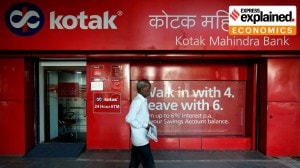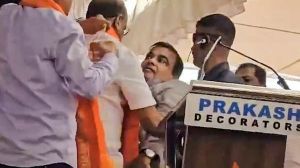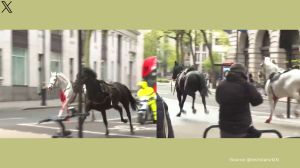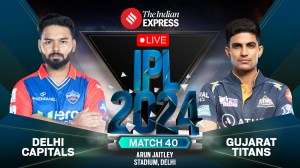- India
- International
Pranab Mukherjee’s role in deciding Yakub’s petition raises fresh questions on powers of President’s office
If former president Kalam’s death revived the idea of a ‘People’s President’, Mukherjee’s role in deciding the mercy petition of the Yakub Memon raised fresh questions on the powers of the office.
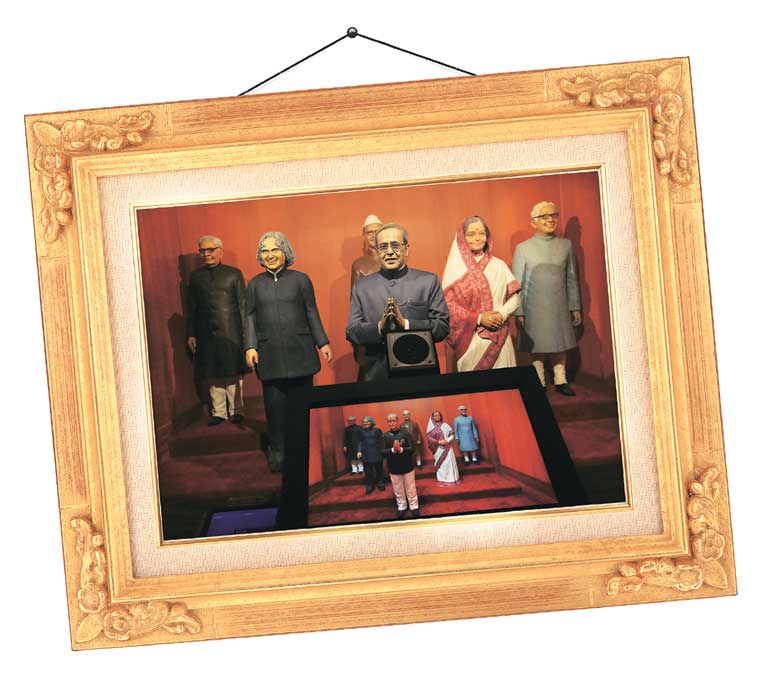 The statues of President Mukherjee and his predecessors at the Rashtrapati Bhavan museum. (Source: Express photo by Renuka Puri)
The statues of President Mukherjee and his predecessors at the Rashtrapati Bhavan museum. (Source: Express photo by Renuka Puri)
In parliamentary democracy, the presidency is higher on symbolism than real powers. However, as the mourning for President Kalam and the wait for President Mukherjee to decide on a mercy plea last week showed, a lot lies in the middle. SEEMA CHISHTI on the post and its positions
It is India’s highest office, represented by one of the grandest buildings in the country. The occupant is No. 1 on India’s electoral rolls, the head of the Indian State, and the Supreme Commander of its defence forces. However, the President of India has seldom been a figure of such discussion as in the past week — for two significant but wholly unconnected events.
If former president A P J Abdul Kalam’s death revived the idea of a ‘People’s President’, and how that may have altered the presidency, Pranab Mukherjee’s role in deciding the mercy petition of the 1993 Mumbai blasts convict Yakub Memon raised fresh questions on the powers of the office.
While introducing the draft of the Constitution on November 4, 1948, B R Ambedkar had said, “Under the draft, the President occupies the same position as the King under the English Constitution. He is the Head of the State but not the Executive. He represents the Nation but does not rule the Nation. He is the symbol of the Nation.”
Though symbol may be a word often used for the president, since the beginning, the powers and boundaries of the post in relation to the government in a parliamentary democracy have been shaped by occupants on either side.
The first president, Rajendra Prasad, took over at the time of the strongest executive in the country, led by doyen Jawaharlal Nehru. Still, over his two terms, Prasad clearly drew the lines for his presidency.

Says constitutional expert Subhash Kashyap, “I don’t see any big change in recent years. The first two presidents themselves, despite a formidable leader like Nehru, made their differences known. As did Nehru.”
Correspondence between Prasad and Nehru on matters such as whether the reconstructed Somnath temple in Gujarat should be inaugurated by the head of the state would go down in history. Prasad, a political heavyweight who had worked with Mahatma Gandhi, was a social conservative and protested against the Hindu Code Bill (for reforming Hindu personal law) that Nehru was pushing, and made his opinions known.
Not many successive presidents would take on governments as directly as that. But for some scholars, what’s more important is the special role they perform as “institutions” — or as the “national conscience”.
President Mukherjee’s press advisor Venu Rajamony points to the crucial distinction in how the president is sworn in. While the president swears “to preserve, protect and defend the Constitution”, the executive takes oath to “act under the Constitution”.
Says political scientist Prof Zoya Hasan, “When executives are powerful, presidents are expected to be part of those institutional structures that give a voice to those who may otherwise go unheard.”
Speaking specifically of Yakub Memon’s hanging, scholars such as Hasan believe the presidency wasn’t active enough. “On issues that have serious ethical and moral implications, where the president is not bound by the aid and advice of the council of ministers, the president could have forced the government to rethink, at a time when there is so much divide — even the judiciary was divided — and where there was a case of ‘beyond reasonable doubt’,” Hasan says.
In this case, she adds, President Mukerjee may have narrowed the wiggle room available to his post.
Article 74 of the Constitution says the president of India shall be assisted by a council of ministers to discharge his duties and would act on its “aid and advice”. The initial ambiguity on the matter ended with the 44th amendment in 1978, which bound the president to this advice. The Supreme Court later underlined this. While this may have reduced the president’s freedom to act, he or she has enough scope to play a role.
And one of the areas where they play a significant role is the power to grant pardons and to suspend, remit or commute sentences, under Article 72 of the Constitution.
This was the power exercised by former president Shankar Dayal Sharma when, in 1997, he stopped the execution of two boys from Andhra Pradesh at the last minute, on a petition led by writer Mahasweta Devi. This, despite having rejected the convicts’ mercy petitions earlier.
Gopalkrishna Gandhi, who was secretary to ex-president K R Narayanan and is a former governor, urged President Mukherjee to use these powers to stop Yakub’s hanging, on the eve of the execution. Speaking of the unique powers of the president, he said, “The head of the Indian republic, as president K R Narayanan memorably said, is guided by the prerogatives the Constitution gives him, and the privilege of intervention which his vast moral influence confers on him.”
Scholars point to other instances where the moral weight of the president came to bear on the government. Letters written in March 2002 by then president Narayanan to prime minister A B Vajpayee have not been revealed even under the RTI, but it was enough of an embarrassment for the government that the president was raising questions about the Sabarmati train burning and the riots that followed in Gujarat.
Perhaps the most significant thing presidents do is decide who to call to form the government when no party has a clear majority in the Lok Sabha. President Shankar Dayal Sharma famously allowed the BJP to govern for 13 days in 1996, perhaps knowing fully well that they would not be able to show a majority. Vajpayee eventually quit before even taking a vote.
Sharma’s successor Narayanan insisted on ‘letters of support’ from parties to a minority government as a verifiable way of determining its numbers. It was the delay by AIADMK leader J Jayalalithaa to send that letter to the NDA in 1998 which revealed the fissures in that arrangement.
Kalam’s aides speak of how agitated he was when, in 2004, Sonia Gandhi, the then Congress Parliamentary Party leader, did not stake claim to form the government for two days after the results, despite letters of support of other parties reaching Rashtrapati Bhavan. “He asked if it would be best to invite her,” says a senior member of Kalam’s team, S M Khan. “Contrary to rumours about Kalam saheb being hesitant to call her, it was only when he wrote to her asking when she would want to come that she called to set up time.”
The other way presidents have been nudging governments to reconsider their views or at least encouraging debate has been in signing of Bills and ordinances.
The closest a president and a prime minister came to a breaking point was during Giani Zail Singh and Rajiv Gandhi’s terms, after the Congress had come to power with the highest numbers any government has ever had in Parliament. It took some persuasion by senior political leaders and advisors for Zail Singh to give up the idea of attempting to “dismiss” the Rajiv government.
In his memoirs, Singh wrote that he felt isolated and therefore spread the idea of a possible “dismissal” to send a warning to Rajiv. He also wrote that the then prime minister also considered the idea of “impeaching” him. However wild the “dismissal” idea was, Singh succeeded in 1986 in sending back the Indian Post Office (Amendment) Bill, expressing fears of intrusions in what was being posted and mailed. By raising the spectre of Emergency, Zail Singh succeeded in riling the Rajiv-led executive.
The only time a president actually stalled a legislation, however, was concerning one to provide generous pensions and allowances for MPs. The Bill regarding this was sent back by president R Venkataraman in 1989. The National Front government of V P Singh subsequently dropped the legislation.
In September 2013, it is believed, President Mukherjee advised two ministers in the Manmohan Singh government to not persist with the ordinance that would override the Supreme Court ruling barring convicted MPs from office. After Rahul Gandhi also took a strident line on the ordinance, it was not brought back.
The actions of these presidents were in sharp contrast to, say, what Fakhruddin Ali Ahmed did in the post, when he signed the Emergency papers at midnight in June 1975, without much ado.
Since Venkataraman, other presidents have also returned legislation. These actions have fuelled debate on issues of propriety surrounding a legislation, often tipping the scales of public perception. In September 2002, in his first year, for example, Kalam returned the Vajpayee government’s ordinance seeking to overturn the Election Commission rule that candidates must make disclosures of assets, liabilities and criminal antecedents, if any, or else be disqualified. Now of course this is routine, but 13 years ago, the Vajpayee government re-sent the ordinance to then president Kalam. And he had to sign it.
Article 143 too gives the president the power to “consult the Supreme Court” on any matter of law or fact. The president enforcing a pause for “consultation” is in itself sometimes more effective as a counterpoint than a returned Bill.
Pratibha Patil’s aide Archana Datta wishes more credit is given to the first woman president. “The press was very unjust, perhaps because she was a woman. But she was sharp, hardworking and took steps like establishing a forum for meeting governors. But no one talks about it in the way PURA (Providing Urban Amenities to Rural Areas), an initiative by Kalam, is spoken of.”
What is also significant is that while Patil, who served only under one government — the one that elected her — was seen as a rubber-stamp president, she ensured there were no executions in her tenure, and commuted the most death sentences. The UPA government that had appointed her had to wait for Mukherjee to take over before hanging Ajmal Kasab and Afzal Guru in quick succession.
The presidents have also through their stature guided the government’s approach on issues. S Radhakrishnan’s commitment as a teacher, for example, helped establish the early respectability for the profession. Narayanan’s famous comment in an interview that pedestrians must also have space on the new glitzy highways was seen as a veiled critique of the NDA’s economic policy.
Mukherjee’s advice against excessive use of ordinances, during a speech on January 20, 2015, were interpreted as directed at the Narendra Modi government that had pushed through several just before that.
Conversely, because of the sheer symbolism of their office, presidents also help the government assuage fears and refurbish their own image. If Zail Singh was seen as a Sikh symbol required by the troubled Indira in the early 1980s, Kalam was the Muslim face needed to recover ground from issues the Gujarat riots had raised for the NDA.
Even earlier on, in 1967, the man entrusted by Mahatma Gandhi to help hone his philosophy of education, Dr Zakir Hussain, brought his particular concerns to the presidency — especially for culture and nature. As the first Muslim president, he also helped showcase the “composite India” theme less than two decades after Partition.
For the same reasons, the Opposition has sometimes flocked to the president as the highest office to address their concerns —like during the Gujarat violence of 2002.
Just the election of a president can also herald changing times. In 1969, Indira Gandhi called for a ‘conscience vote’ by Congressmen while seeking votes for her candidate V V Giri against Neelam Sanjiva Reddy, known to be close to her rivals. Giri won, and the Congress was changed forever.
Kalam was the other turning point. While most close aides of former presidents agree on its “uniquely political function”, he brought to the presidency a new sensibility.
Says S M Khan, “From the first meeting on assuming office, Kalam saheb was desperate to break with protocol. He did away with the need for presidential cars/convoys to go on outstation trips, and on every request being routed elaborately. His office enabled him to connect with thousands of people.”
There has been periodic clamour for a ‘US-style presidency’ in India, its reported supporters including, among others, the late Sanjay Gandhi and former deputy prime minister L K Advani. While that is unlikely in the foreseeable future, even in the face of once again a powerful executive — or perhaps because of it — no one sees the role of the president diminishing just yet.
WHAT THE PRESIDENT CAN DO
* Takes oath to preserve, protect and defend the Constitution, making the post unique and special.
* Takes salute on Republic Day as he is the Supreme Commander of the Armed Forces.
* Is No. 1 on the protocol list, followed by the Vice-President, and then the Prime Minister.
* The executive power of the Union is vested in the President, and this power is to be exercised directly or through subordinate officers.
* All Bills and ordinances passed by Parliament have to be signed by the President for them to become law. The 44th amendment to the Constitution passed in 1978 takes away the power of the President to refuse to sign a Bill he has sent back once, by insisting he signs it if it is re-sent.
* Is the Visitor at several institutes of higher education.
* Has the powers to grant pardons etc, or to suspend, remit or commute sentences in certain cases.
* Has the power to consult the Supreme Court on a matter of law or fact that has arisen or can arise.
* Can be impeached if there is a charge of having violated the Constitution, though a two-thirds majority in both Houses of Parliament has to agree. He has the right to defend himself
WHAT THE PRESIDENTS DID
Rajendra Prasad (1950-62)
The only one to have served two terms as president, made his disagreement with PM Nehru’s ideas of social reform well known.
S Radhakrishnan (1962-67)
Educationist, Teacher’s Day marks his birthday.
Zakir Hussain (1967-69)
First Muslim president, educationist, first to die in office.
V V Giri (1969-74)
His election heralded Indira Gandhi’s ascendancy in the Congress.
Fakhruddin Ali Ahmed (1974-77)
Slammed for signing Emergency proclamation without asking too many questions.
Neelam Sanjiva Reddy (1977-1982)
His election signified the new mood, represented the anti-Indira section of the Congress.
Zail Singh (1982-1987)
Best known for transformation in office from a loyalist to having the biggest tussle with the executive
so far.
R Venkataraman (1987-1992)
The first president to work with four PMs and appoint three of them, during a phase of intense political activity in India. Returned a Bill that was never sent back.
Shankar Dayal Sharma (1992-1997)
Also worked with four PMs and appointed four of them. Held to the principle of inviting the single largest party to form the government.
K R Narayanan (1997-2002)
The first Dalit President, he evolved the principle of letters of support and demonstrable strength for government formation. Did not hesitate to speak his mind, on economic and social issues.
A P J Abdul Kalam (2002-2007)
Known variously as Missile Man and the People’s President, he was the first non-politician in office.
Pratibha Patil (2007-2012)
India’s first woman president, blighted by controversies, worked with only one PM. However, held a firm line on death penalty and did not yield to government pressure on it.
Pranab Mukherjee (2012 onwards)
An active politician before being appointed President, he is said to enjoy wide cross-party support. Has indicated his reservations about ordinances being brought needlessly by government, but has signed them all so far.
Apr 24: Latest News
- 01
- 02
- 03
- 04
- 05
















